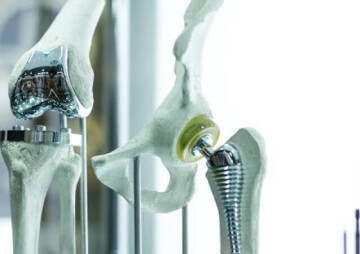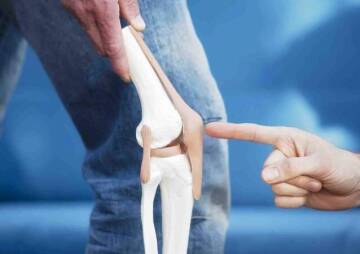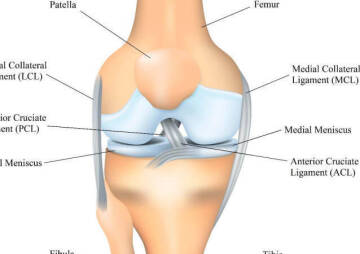-
Category
Craniomaxillofacial Surgery
Orthopedic Surgery
Spine Surgery
Orthopedic Implants
Hip Surgery
Knee Surgery
Pectus Excavatum
Bone Graft
Disinfectants
Healthcare
What Is Knee Replacement?

This article will explain all you need about the knee joint replacement procedure and the pre-and post-operative procedures, side effects, and cost.
The knee is one of the most vulnerable parts of the body that plays an important role in your daily life. Thanks to a healthy knee, you can walk, run, sit, get up and climb the stairs. Although your knees can support your weight, a slight blow or a disease can damage your knees and cause serious problems. Sometimes pain and injuries in the knee due to various reasons such as osteoarthritis cannot be treated in any way. Knee replacement is the most effective way to alleviate pain in these conditions. What is knee replacement? A knee replacement is a surgical procedure in which a damaged knee joint is replaced with an artificial joint.
This is a complicated and slightly challenging procedure that necessitates surgical skill and experience as well as special post-operative care. This article will explain the knee joint replacement procedure and the pre-and post-operative procedures, side effects, and cost.
Types Of Knee Replacement Surgery And How They Are Performed
.jpg)
Surgeons perform two types of knee replacement surgery depending on the severity of the knee damage: total knee replacement and partial knee replacement.
Total knee replacement or arthroplasty is suitable for people whose knee joint is completely worn and or damaged due to osteoarthritis, rheumatoid arthritis, or other health conditions. In this operation, both sides of the worn ends of the knee joints are replaced with prostheses. Total knee replacement is the most common method which is performed on people between the ages of 60 and 80. During surgery, the doctor cuts the worn ends of your thigh bone and shinbone and replaces them with the curved piece of metal and the flat metal plate, respectively. Then, to prevent friction, a plastic spacer is inserted between the metal parts; in fact, this plastic plate serves as cartilage. And finally, the doctor sutures the wound, and you must stay in the hospital for 3-5 days.
Partial knee replacement is the simplest method and is suitable for patients whose knee joints have been damaged on one side. Since the knee joint on one side has been replaced with a prosthesis, the wound will be minor, and less bone will be cut in this situation. Doctors prescribe this method for 1 in 4 people with osteoarthritis, and it has a shorter hospital stay and recovery period than the previous method. Another benefit of partial knee replacement is that you can bend your knee more naturally than complete knee replacement.
Some of the most popular questions patients have about knee replacement surgery are: What are knee replacement materials? Which method is best for me? In response to the first question, the artificial knee joint comprises a metal and a high-grade, wear-resistant plastic. The metals used are cobalt-chromium and titanium alloys. And which method is right for you depends on your doctor's diagnosis and the degree of joint damage. However, keep in mind that knee replacement surgery is a significant procedure that should only be considered as a last choice for patients whose pain does not ease with physiotherapy and steroid injection.
Who Are The Best Candidates For Knee Replacement Surgery?
Arthroplasty is the last option for people who have limited mobility and pain even when at rest. Over time, you may be wondering what causes damage to your knee joints. Osteoarthritis is the primary cause of damage to your knee bones over time, and the symptoms appear as you age. In addition to this, other health conditions like Haemophilia, knee injury, Gout, and Rheumatoid Arthritis can cause knee damage.
In this case, people will experience severe pain in their knees after a while, which will affect their routine and daily activities and reduce the quality of life. You may try various therapies to alleviate pain during this period, but when your knee joint is completely worn out, your only choice is a knee replacement. There are some signs that you are ready to have a knee replacement, some of which include:
- Swelling and stiffness in your knee joint;
- Moderate to severe knee pain, even at rest;
- Severe pain that disrupts your personal life and sleeps;
- Everyday tasks such as shopping and getting out of the bath become impossible;
- Knee pain with deformity and deviation of the knee;
- Pain does not alleviate even with anti-inflammatory medications;
- You're depressed as a result of your pain and lack of mobility;
- You are unable to work or having a social life
- Extreme knee joint pain restricts everyday activities such as walking, climbing stairs, sitting, and getting up from a chair.
These options indicate that you need to have this surgery to get back to your normal life. Risks and recovery time may scare you, but don't worry; if you choose a professional surgeon, you will not have a post-operative problem. Furthermore, preoperative preparation is needed to have a simple operation with minimal side effects.
Before And After Knee Replacement Surgery
Before any surgery, you need to be mentally and physically prepared. Get more accurate and reliable information about arthroplasty and familiarize yourself with the procedure. You can do this by reading informative articles on different websites or asking people who have had arthroplasty surgery to share their experiences with you. To have a short recovery period, strengthen the muscles around your knee by doing special and strengthening exercises weeks or months before the procedure. Doctors recommend gentle exercise such as walking or swimming before knee replacement surgery. To familiarize you with all of the procedure's steps, here are the steps to take before, during, and after the operation.
Before The Surgery
- Before the procedure, you will sign a consent form, read it carefully, and ask your doctor any questions you may have.
- Your doctor may order a series of tests, such as a blood test, to make sure you are in good health before going to surgery.
- Be sure to talk to your doctor about all medications and chemical and herbal supplements you take.
- Tell your doctor if you are allergic to any medication, anesthesia, or metal; otherwise, it could pose a serious risk to you.
- If you have a history of bleeding problems or are taking anticoagulants such as aspirin, tell your doctor.
- Avoid alcohol and smoking about two weeks before the surgery; otherwise, the risk of dangerous bleeding will increase on the day of surgery.
- You must fast for eight hours before the procedure.
These are some general tips that are almost the same for all patients, but the doctor can prescribe other special preparations for them depending on the patient's physical condition and health.
The Day Of Surgery
- Your anesthesiologist will put you to sleep with general anesthesia to make the surgery more effortless for you.
- A urinary catheter may be inserted after you are placed on a surgical table.
- At the site of surgery on your knee, the surgeon will make small incisions.
- Then, the worn end of the knee joint is replaced with an artificial joint made of plastic and metal.
- Finally, sutures or surgical staples will be used to close the incision.
- You will then be taken to a recovery room to have your vital signs monitored.
You will not notice or feel any of the above steps. But do not worry; the anesthesiologist and all surgical team members will regularly monitor your general condition and vital signs. You will be moved to the surgery ward, and your post-operative treatment will begin once your general condition has stabilized and you are alert.
After Surgery
- You will be prescribed painkillers to reduce the pain;
- To drain fluid from the incision site, a drain may be inserted;
- 12 or 24 hours after the operation, you should get up and walk with the staff's help;
- While you are in the hospital, a physiotherapist will teach you specific exercises to strengthen your knee;
- From the day after surgery, you can slowly start exercising;
Typically, you should stay in the hospital for 3-5 days, but this could be shortened to 1 to 3 days, depending on your general condition. The main stage of your recovery period will be at home, and you should be very careful with your new knee.
Actions Needed To Care For The New Knee
You can take many steps to care for your new knee joint, but strengthening exercises are an important part of your recovery plan. Do these exercises regularly under the supervision of a physiotherapist so that you can quickly resume your everyday life. The following steps also will help you take care of your knee prosthesis:
- To reduce swelling, raise your leg while sitting and apply an ice pack on the operated area every three or four hours for 20 minutes.
- For the first six weeks after your surgery, do not sit with your legs crossed.
- Avoid physical activity that causes your knee to twist.
- Do gentle exercises as well as light walking to reduce stiffness in the knee joint.
- Never put a pillow under your knee while sitting or sleeping.
- Do not drive for 6-8 weeks after surgery, and be sure to consult your doctor to resume driving.
- For the first three months, do not do heavy chores such as vacuuming or moving furniture at all. You can only do simple things like dusting and washing.
- Do not have sex for 6 to 8 weeks after surgery.
What Do You Expect After Knee Replacement Surgery?
.jpg)
Before having a knee replacement, you should consider how much it will affect your return to normal life. Most people expect this operation to solve their problem completely, but this is not a realistic expectation. Arthroplasty significantly reduces your pain and improves your mobility and a better quality of life. About 8 weeks after surgery, you can do activities such as walking, swimming, cycling, driving, and climbing stairs. However, keep in mind that the artificial joint will never act as a healthy knee for you, and you must take great care of it. Activities such as running, jumping, hiking, skiing, tennis, and lifting heavy objects can be a serious threat to the knee prosthesis's survival. However, this surgery will significantly reduce the pain caused by knee abrasion, and for people who have pain even at rest, this may be the only thing they expect from surgery. Nevertheless, to have a comfortable life after the operation, you need to take care of your artificial knee for years.
How Long Does A Replacement Knee Last?
The full recovery process after the surgery takes about two years; during this time, you can accelerate the restoration of the muscles around the knee by strengthening exercises. A common misconception among people who have a knee replacement is that they think the prosthesis will last forever. However, this is not true, wear and tear in daily use over time causes damage to the plastic part of the artificial joint. According to the National Joint Registry (NJR), one in 20 people who have the surgery will need reoperation after 12 years, depending on the type of knee replacement surgery. This shows that these prostheses are not permanent, and this period may be shorter if you do not take care of them properly.
The Side Effects Of Knee Replacement Surgery
.jpg)
All surgeries have side effects that can be mild or severe, depending on the patient's condition. In addition to the patient's condition, this may depend on the surgeon's skill and experience. According to statistics, patients who choose professional and experienced surgeons for knee replacement experience minor post-operative complications. Arthroplasty can also cause moderate to serious side effects, which doctors report occur in 1 in 20 cases. Fortunately, most of these side effects are minor and go away after a while. Here are some common side effects of knee replacement surgery:
- Side effects related to anesthesia include sore throat, aches and pains, drowsiness, vomiting, shivering, and breathing difficulties. Anesthesia-related side effects are rare but common in people who are allergic to anesthetic medications.
- Deep vein thrombosis (DVT) refers to forming a blood clot in a vein deep within the body, one of the most dangerous and common side effects of orthopedic surgery. This blood clot can reach the heart and lungs through the bloodstream and can be life-threatening if left untreated.
- Unexpected bleeding inside the joint usually occurs due to the use of anticoagulants that are prescribed to patients after surgery.
- Infection is one of the most serious and rare side effects of knee replacement surgery. According to statistics, about 1.5% of patients experience joint and wound infection for three months after surgery.
And other complications such as:
- Wound complication
- Continued Pain or Stiffness
- Implant Loosening and Fracture
- Allergy To Artificial Joint Metals
- Loss Of Motion
- Popliteal Artery Complications
- Nerve Damage
- Death
Alternatives To Knee Replacement Surgery

Fear of surgery, particularly knee replacement, is one of the main reasons why patients are always looking for alternative therapies. They usually worry about side effects, recovery, and most importantly, do not want to lose their knees. Nowadays, doctors usually suggest other alternative methods to patients. These methods include:
Mini-Incision Method
Mini-incision surgery is one of the most sought-after methods that the surgeon often uses for partial knee replacement. In this method, the surgical team makes a smaller incision than the standard incision method and uses a special tool to maneuver around the tissue. Shorter recovery time and no extra incision are the advantages of mini-incision surgery.
Patellofemoral Replacement
Another name for patellofemoral operation is the kneecap replacement operation, which is the best option for those with kneecap damage. Thus, thanks to this simple operation, it is no longer necessary to perform a total or partial knee replacement surgery for kneecap damage.
Image-Guided Surgery
This is a state-of-the-art method for performing arthroplasty and has no incision and post-operative complications. The surgeon uses computerized images generated by attaching infrared pointers to parts of your leg and surgical instruments to perform image-guided surgery.
Patient-Specific Arthroplasty
As the name suggests, this arthroplasty method is a particular procedure for each patient. In this method, each prosthesis is made specifically for each patient to be ultimately fit for him/her. Patient-specific arthroplasty is an advanced type of knee replacement, and doctors believe it may last longer than a standard prosthesis.
How Much Is A Knee Replacement?
Artificial knee joints are generally costly since they are made of special, high-quality metal and plastic. Knee replacement surgery is generally a complex and challenging surgery that requires high precision. Reports say the average cost for a total knee replacement in the US is $ 50,000, and the average cost for a partial knee replacement is 10-20% less than the total arthroplasty.
And The Last Word…
If medication, changing daily life activities, and physiotherapy does not help reduce the patient's problems, the last choice is to replace the knee joint. Before having the surgery, try to learn more about the procedure, side effects, and recovery period. You can do this by consulting with your doctor and asking her/him to show you knee replacement before and after pictures or by reading scientific papers on reputable websites. If you are one of those who have done this, write down your experiences for other users to use.






